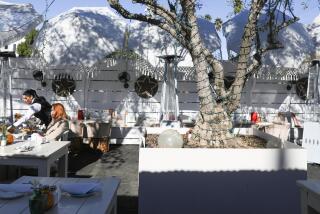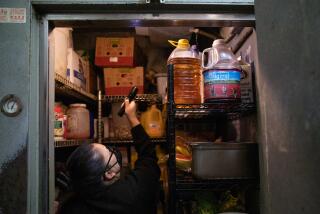Operations menu can help eatery’s sales heat up
Kevin Reynolds is hoping for a long, hot summer.
He’s not chasing a tan. He’s hoping to attract more customers to his beachside concession stand, Kevaccino’s on the Beach, in Playa del Rey.
“When it cools off to 60 and 65, it just kind of blows me out of the water,” said Reynolds, who cooks and staffs the walk-up order window with the help of three employees.
This will be the third summer Reynolds has run the concession, and it has been challenging. Although the business was in the black last year, he used most of the profit toward paying off start-up costs, including credit card bills.
He’s hoping to increase sales, but among the challenges are nearby construction and strict Los Angeles County rules on parking and signage.
Then there’s the fact that his stand is on a relatively remote part of Dockweiler State Beach that gets fewer visitors than other spots along Santa Monica Bay. This was perhaps a prime reason he had no competition when he applied for a five-year lease on the structure that is owned by the county and overseen by its Beaches and Harbors Department.
“I’d like to do well enough that I can just rebid on it” when the lease is up, Reynolds said.
At $7,500 a year, his rent is low. Sales hit $80,000 last year.
Kevaccino’s faces challenges, but so does every business, said James Sinclair, principal at Los Angeles-based OnSite Consulting Inc., which specializes in the hospitality industry.
Sinclair visited the business and made these recommendations:
• Get organized. “You can’t hit critical mass unless you can leave the business” and be confident it will be well run, Sinclair said.
To accomplish that, Reynolds should create a one-page form or checklist that outlines standard operating procedure (SOP) for all major tasks.
“When people hear SOP, they think IBM, but it’s not true,” the consultant said. “The smaller the business, the more it needs it so it is not as reliant on the owner.”
Checklists should cover opening procedures and end-of-day cleaning and closing. Safety checklists are also important, including how to handle and store food, especially if the electricity goes out as it did recently.
• Control inventory and costs. Keep the unit fully stocked; it will save trips to pick up food and supplies. And shop at a restaurant supply warehouse, such as Restaurant Depot, to save money, Sinclair said.
Reynolds should have separate inventory lists for summer and winter. “I’m not asking people to be desk clerks, but administration is part of running a small business,” Sinclair said. “If you go through it once, it will make your life easier forever.”
• Hire a trained cook. “A trained line cook can help him organize and clean his kitchen, and improve the quality and consistency of his food,” Sinclair said. Reynolds doesn’t need a fancy chef, just an experienced restaurant cook who can handle basic fare.
• Develop a concept and a signature item. Figure out what the food concept is and stick to it, Sinclair said. Currently Kevaccino’s has “a little bit of everything, “ he said.
“If the concept is great American food, then he should have the biggest, baddest hamburger around or chili dog or pastrami,” Sinclair said.
• Rework the menu board. “The menu board is everything. It represents your business,” he said. The current, worn menu board doesn’t encourage people to spend, the consultant said. Reynolds could add more preset food combinations, sack lunches and picnic baskets to go.
“There is plenty of opportunity here,” Sinclair said. “But it needs to be run like a business and not like a hobby.”
If your small business could benefit from a free Business Makeover in the Los Angeles Times, please email smallbiz@latimes.com.






